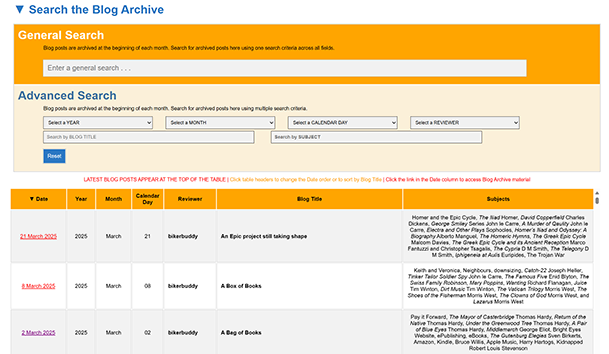▼ Blog

21 May 2025
The International Booker Prize 2025 Announced
It just so happens that international time differences mean that when I woke this morning to have breakfast at 7am Sydney time, I was just in time to watch the announcement for the International Booker Prize for 2025 on my iPad as I ate.
I reviewed Hiromi Kawakami’s Under the Eye of the Big Bird two days ago and predicted that it wouldn’t win even though it appeared to be the favourite to do so. Yesterday morning, without checking the actual times for the ceremony, I quickly rewrote parts of the review because I thought I’d come across as far more negative than I intended to be. I wanted to get my revised version up before the prize was announced. What I was trying to convey was that some readers might find the structure of the book a challenge. It just takes a few chapters for things to become clearer about what exactly is happening. Under the Eye of the Big Bird is topical and I thought it was a good book.
I needn’t have rushed to do my rewrite, though. As I have said, the actual announcement was another day away. Banu Mushtaq won the prize for her series of short stories, Heart Lamp. Naturally, I will try to acquire a copy and review it as soon as I can as part of our Booker Prize Project. In the meantime, if you are interested to read more about this book, you can visit the Booker Prize site by clicking here.
I refrained from trying to guess a winner this year. I prefer to do that for shortlists I have been able to read, although something in the zeitgeist sometimes encourages me to make an uninformed guess. Had I done that this year, I must admit, I wouldn’t have got it. This is mainly because V.S. Naipaul won the Booker in 1971 for In a Free State. In a Free State was a series of short stories and novella set in an unnamed African country and there hasn’t been a series of short stories chosen for the Booker Prize since. But the International Booker was set up to showcase books from cultures around the world, and this has to reflect a broader range of storytelling.
I purchased Under the Eye of the Big Bird in Penrith the other week. It was the only book in the shortlist they had. I was thinking I might go to Sydney today and try to find a copy of Heart Lamp, but it’s raining and Sydney trains are in chaos at the moment due to some technical issue. Victoria, who is in Parramatta today for work, has promised to try to get me a copy. In the meantime, I started reading Aldous Huxley’s Island last night.
- bikerbuddy
17 May 2025

C Somnus McGill
A New Reviewer!
Yesterday I published a review by a new reviewer from the United States, C Somnus McGill. He is an academic who teaches writing and composition. He first contacted us via our Guestbook in March, expressing an interest in writing a review, and later by email.
His review is for Kim Leine’s The Prophets of the Eternal Fjord, a piece of historical fiction based around proselytising efforts of the Dutch Church in Greenland in the late 18th century. C Somnus McGill encourages us to read this book in the most enthusiastic terms. I must admit, only that I have so many books already backed up, I would have ordered a copy myself. However, given that I know my nature, if I ever see Leine’s book on a bookstore shelf, I’m not likely, now, to resist its allure.
Thanks to C Somnus McGill for your excellent review. I don’t know whether we will see any further reviews from you, but they will be most welcome if you send them!
- bikerbuddy
16 May 2025
Bathurst Book Fair 2025
Victoria asked me whether I would like to accompany her to the Bathurst Book Fair. The Book Fair has tens of thousands of second hand books, many in pristine condition. The fair is run by volunteers and 100% of the proceeds from the fair go to Lifeline, an organisation that provides 24/7 crisis support and suicide prevention services. It seemed like a good idea for a day out.
I thought I would document our trip here. First, is the journey itself. We live in Springwood in the Blue Mountains west of Sydney, and Bathurst is roughly 130 km west of us by road. To get there we have to drive through the upper mountains and descend to the western plains (which are more like rolling hills at this point), and then onward to Lithgow, a coal mining town where my father grew up, and then on to Bathurst where the Bathurst 1000 is held each year in October. It’s an endurance race with V8 touring cars. This map here shows the route we took. The image has been modified to reduce its size. If you click on the map you can view the area properly on Google Maps:

We spent some time at the fair. It was held in a pavilion at the Bathurst Showground. The books were in two large rooms in boxes on trestle tables, with more books in boxes below the tables. Victoria seemed to have an armful of books within a few minutes of us getting there, while I strolled up and down. I was not really wanting to buy more books, since I have such a backlog, but I was willing to get anything I thought of special interest. Here are some photos from our time at the fair:

Me walking towards the pavilion

Victoria's first selections

The fiction section

The non-fiction section and other books
I started helping Victoria carry her books, fearing they were about to topple from their balanced position in her arms, but I saw this was only a temporary solution. I suggested she buy what she already had, return to the car and then bring back a large shopping bag. She wasn’t the only one with huge book purchases. Some people had brought trolleys, others had large bags. This is because the prices were so low and the condition of most of the books was excellent. The charity asked for a gold coin donation to enter (in Australia this is either one or two dollars) and every book I saw was priced somewhere between two and five dollars, although five dollars was rare.
In the end, I bought three books for myself and one for Jenny. Jenny’s book was The Money Club by Fiona Lowe. Jenny had reviewed The School Run by Ali Lowe, but while standing in the pavilion I mistakenly thought I had the same author, especially since the style of cover and type of story was pretty much the same. To be honest, Jenny didn’t notice, either, when I gave the book to her!
I bought Clair Tomlin’s Charles Dickens: A Life. A lovely hardback edition. You can never have too many Dickens biographies, right? I also bought a pristine Folio Society edition of Dickens London and a copy of Leon Garfield’s John Diamond. I read Garfield’s Smith as a child and then later taught it to a junior class. I thought it was about time I gave myself the chance to read another of his books.
Victoria ended up with 30 books! This is her list from a text she sent me:
- 5 x Tuesday Next books
- 9 x China Bayles mystery series
- 5 x penguins
- The Snowman - Jo Nesbo
- The haunting of hill house
- The bee sting
- American gods
- Tinker tailor soldier spy
- The bell jar
- The life and crimes of Harry lavender

Victoria's book haul in the back of her car
- bikerbuddy
1 May 2025
Our new search page for the blog archive
Nominally, I’ve been reading A Brief History of Seven Killings by Marlon James. I’ve made some progress, but in reality, my time has been sucked away by a new search page I’ve been designing for old blog posts that I keep. The blog page has been maintained since June 2018 when someone commented that there was no About page or blog on the website. I was just trying to make things work at that time and get some reviews up, but I swiftly created those pages, and since then I archive blog posts at the end of each month.
Of course, the list of pages has been growing since then and whenever I have wanted to look back at an old post it can take some time to find it. Things are usually much further in the past than I realise. The list of dates that linked to the pages was useless, and there seemed no use keeping old blogs if I, or anyone else, couldn’t easily search them.
So, I’ve spent over a week trying to get the page together. A lot of the problem has been that any changes I have made to Neocities since I started have been taking hours to register, so it takes so much longer to get anything done: that, and the enormous amount of information I had to arrange and data entry I had to do for the whole thing to work.
About halfway through I wondered if the time I was spending was worth it. But sunk costs played heavily on my mind, so I kept going. I’ve spent all this morning, starting at 6:45, to finish the data entry so I could finally put it behind me. I felt really good when I finished. I went and had lunch. Then I realised that it was the first of the month today. Time to archive more blog posts! But this time I would have to create entries for the new search table, too!
The search page for the blog archive can be found under ‘Blog’ in the menu bar. The link replaces the long list of dates that were previously there. Have a play with it if you want. If you’re a former or recent contributor to the website, you’re bound to find an entry that features you.
If anyone finds mistakes or has suggestions for improvements, I sure would appreciate hearing about it. I’ll get to those as soon as I can. But not today. For the rest of the day, I don’t want to look at my computer!

- bikerbuddy

 RSS Feed
RSS Feed Facebook
Facebook Instagram
Instagram YouTube
YouTube Subscribe to our Newsletter
Subscribe to our Newsletter













No one has commented yet. Be the first!